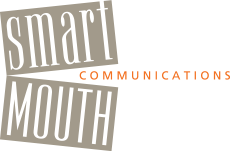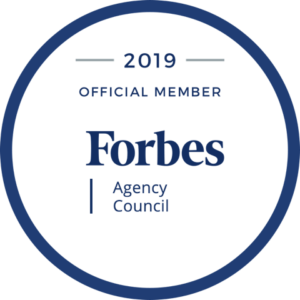by Beth Levine | Jun 14, 2012 | Just Mouthing Off
Interesting phenomenon. Yesterday I was working with a CEO who is filming a series of short video messages to his large and growing employee base. The content is good – simple, straightforward, memorable and repeatable, a little bit of humor, a little bit of info, a lot of focus on the audience. The delivery was a bit more of a challenge; we needed to get him to appear more natural and less stilted on camera. Hmmmm, I thought, let’s ditch the script and teleprompter and have him just chat with the camera. Sounds reasonable, rational, logical, right?
Well, after versions where we had him wing it and just chat, then had him use just bullet points, then fleshed out the bullet points a bit more, we ended up back at the starting point – pretty much a full script running on the teleprompter. Ironically, that’s what helped him relax and appear most natural. In fact, he was quite good, we got some great footage.
In this biz, there are a lot of woulda-coulda-shoulda’s, but in the end whatever works for the individual speaker is the right answer. We’re all wired differently; what motivates us, comforts us, and gives us confidence differs from person to person, speaker to speaker. I could beat each of my clients over the head with the same baseball bat, but it would be pointless. Whatever works best resides within each of them, and so my only role is to help find that and pull it out of them, that’s it.
by Beth Levine | Jun 4, 2012 | quote
“Everything should be made as simple as possible, but not simpler.”
– Albert Einstein
by Beth Levine | May 21, 2012 | Just Mouthing Off
What does it say about you as a speaker when you stand squarely behind a podium or cling to a lectern during your entire talk? We don’t even need to answer that, do we?
Standing firmly in one place – or, even worse, hiding! – doesn’t really advance the cause of connecting with your audience, does it? Any structure between you and your audience is simply a barrier. And it’s a pretty safe bet to figure on it being more than just a physical barrier.
So, what are you supposed to do when a podium or lectern is turned over to you? Step out, people! Go ahead and use it as a prop or as a place to put your “things” (e.g. notes, laptop), but unless you’re addressing a large audience in a large room and the only available microphone is fixed to the podium (the only reason you’d have to stay put!), step out, around and in front. It sends the most important message to your audience … that you’re coming closer to them!
by Beth Levine | May 14, 2012 | Just Mouthing Off
Second 1: Smile
Ahhh, a smile relaxes you and your audience, and it gets everyone ready for something positive to come.
Sounds obvious but it’s not, and those who forget to breathe make themselves more nervous.
There’s no doubt that you will spend most of your preparation time working on the meat of your talk or presentation, i.e. the 15+ minutes that follow the first 8 seconds. But I would encourage you to give just as much thought and care to what you will say right off the bat. It’s standard, expected, and therefore boring and mediocre, to stand up and thank people for having you or offer other polite niceties as an opening. Set yourself apart by standing up and telling people exactly what they will know or feel after your talk … e.g. “you will be inspired tonight” or “you are about to learn all about xyz today” or “we are going to have some fun for the next 30 minutes” or “what you’re about to hear will change how you do business.” Give some thought to your audience’s needs and expectations in relation to your topic, and let them know – as you’re just getting started – what you’re going to give them during your time together.
Audiences will decide inside those first 8 seconds whether you are worthy of their attention, so speakers beware!
by Beth Levine | Apr 17, 2012 | Just Mouthing Off
The focal point, aka the missing link!
What do I mean by that? The focal point is all too often the missing link from a speaker’s talk. When you leave a conference room or a ballroom or an auditorium saying to yourself, “um, not sure what that was all about!” or “what are we supposed to do now?” or “was there even a point to all of that?” then you know the speaker neglected to provide a focal point. The focal point is that little bit of audience guidance you give, where you weave in – in your opening and then reinforce it again in your closing – what it is that you would like them to think or know or do by the time you finish talking and they leave the room. It’s a way of setting expectations, locking in focus, or, as I so often like to say, having everyone in the audience turn their brains to the same channel. When it’s used, the focal point can make a talk so much more effective.
So, let’s focus on focal points for a second …
If your “job” – your communications task (always a verb) – is to inform, review or update, then your focal point will probably be a key takeaway. For example, if you are presenting quarterly results for your division to the board of directors, and the results are extremely positive due to a variety of factors, then your opening will sound something like this: “I am so pleased to be able to tell you that we made a lot of money this quarter. There are three main contributing factors, and I’ll review each of those briefly this morning, but just know that we’ve turned the corner and made a lot of money this quarter.” Key takeaway? Yup, you got it … “we made a lot of money this quarter.” In this case, a key takeaway is the focal point.
If your “job” is to motivate or inspire, then your focal point will look or sound more like a call to action or a charge to the troops. For example, if you are trying to boost company morale after a series of layoffs, and the picture is actually rosier now with a leaner headcount, then your opening at an all-hands meeting will sound something like this: “There is no question that we all have been through a difficult and emotional few months, and we need some healing time. But I would like you to focus on the future now, it holds a lot of promise for all of us. I am going to outline our strategic plan for this year. As I do this, I am going to ask each one of you to be paying attention with an eye toward how your business unit will jump on board and what kind of a positive impact the measures in the strategic plan can have on your numbers. That’s why we’re here. I want you to leave this room with concrete ideas for how you will move forward!” In this case, a call to action is the focal point.
If your “job” is to sell or persuade, then your focal point will be a version of an ask. For example (and let’s switch to non-profit), if you are making a pitch for money (definitely persuading and selling!) and your organization has just completed a multi-year capital campaign during bad economic times, then your opening at your annual fundraising dinner will sound something like this: “Wow, what an amazing group of committed individuals you are! Over the past five years, you accomplished the impossible. Tonight, as part of this amazing program we have put together, I am going to ask you to extend your commitment and make a donation that will help us safeguard the investment all of you have made in the future of this organization.” In this case, an ask is the focal point.
These examples are generic and over-simplified, but the point is that if there is something you want your audience to think or know or do, tell them! Be clear and open and transparent. If you don’t tell them, they may not get there on their own, and then the opportunity you’ve had to be in front of them is squandered. Focus on your focal point, it makes better use of everyone’s time and energies!



